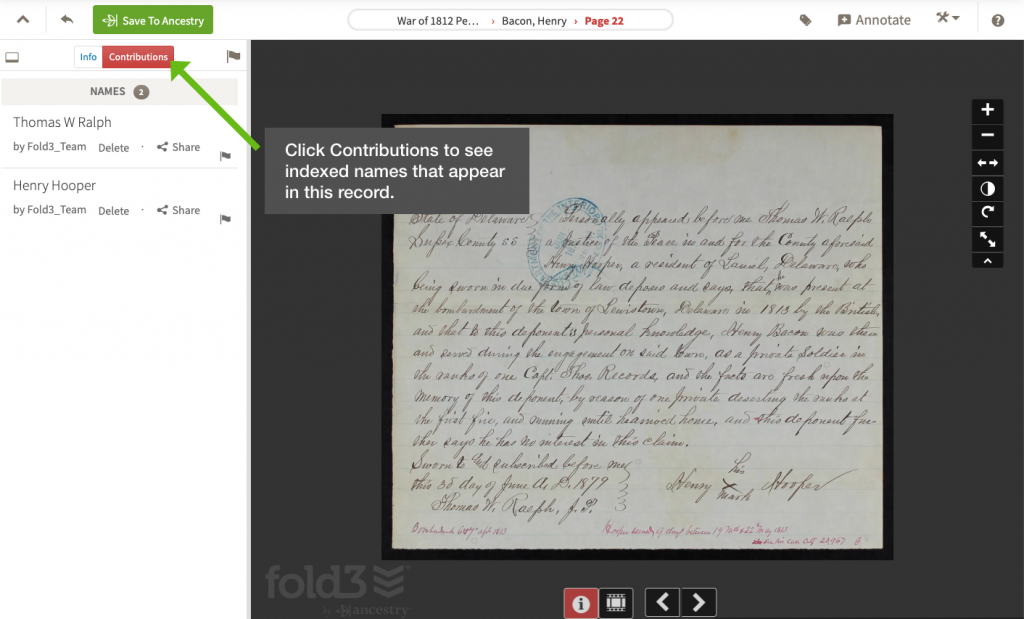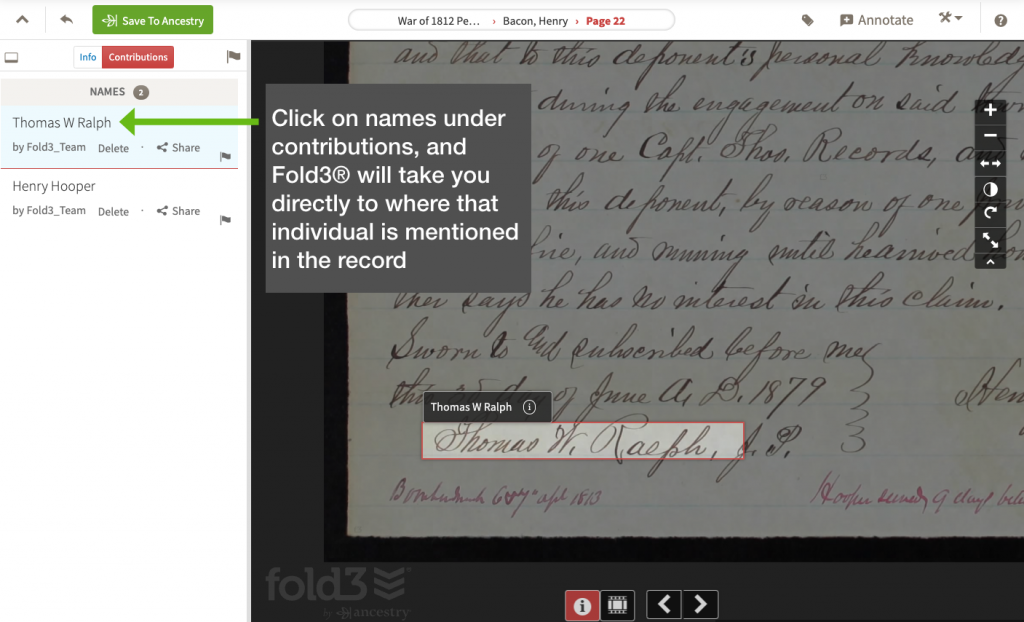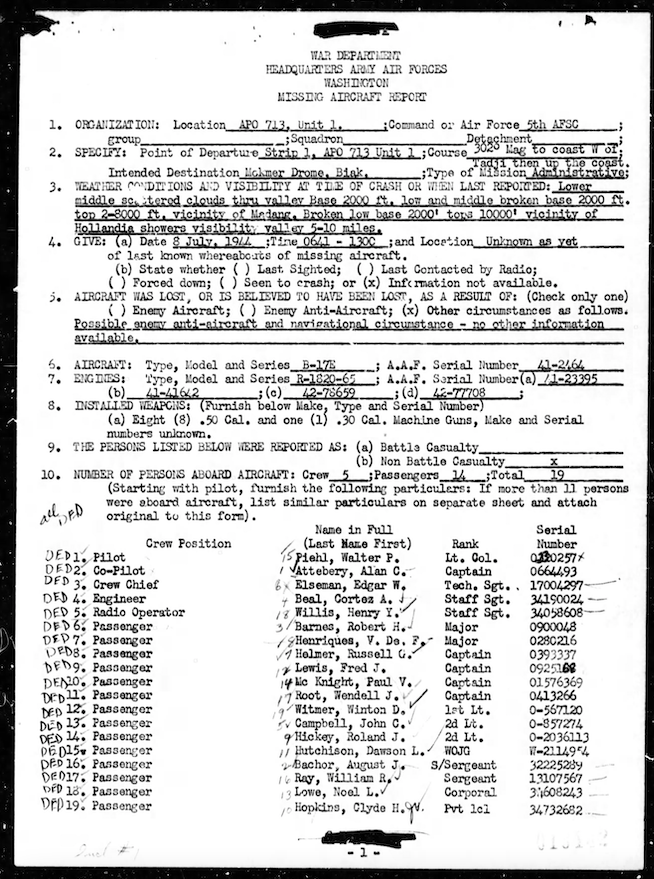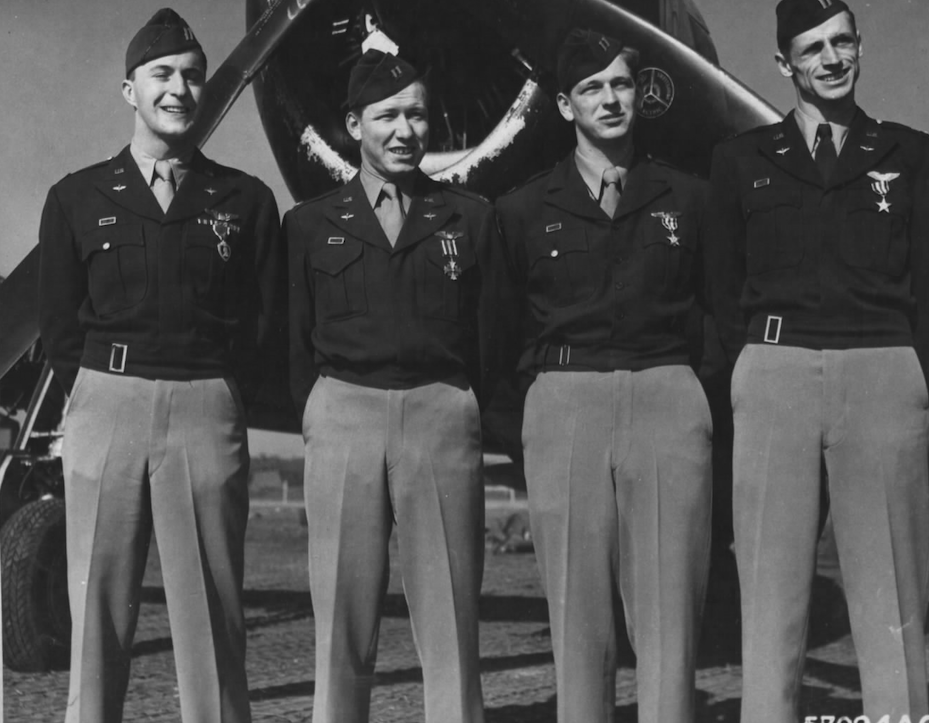Military records are a rich resource for genealogical and historical research. These records provide a treasure trove of information and shed light on the details of service personnel and their family members. Many US military records were lost in a 1973 fire, and Fold3® record collections can help recreate the military history of your ancestors. Following are some search tips to help you make the most of records on Fold3®.
Use Search Filters: Begin your search on Fold3® by using our search filters. As you enter a search term, a pop-up asks if this is a keyword, name, or place. Selecting a filter will dramatically reduce your results, making it easier to access your desired records. Additional filters like conflict/war, military service number, dates, etc., allow you to narrow your results further. Military records differ from vital records, and the record you seek may not use a full legal name. Be sure to try name variations like first initial and last name, for example. Researchers can also toggle back and forth between searching collections and our patent-pending Browse experience. To learn more about Browse, click here.
The 1973 Fire at the NPRC: On July 12, 1973, a massive fire broke out at the National Personnel Records Center in St. Louis, MO. It burned for 22 hours and destroyed 16-18 million military files. Records affected included 80% of Army files for Personnel discharged between November 1912 – January 1960; and 75% of Air Force files for Personnel discharged from September 1947 – January 1964. No duplicate copies of these records were ever maintained. These lost records present a roadblock, but other available record sets can help you construct a military history.
For example, if you are searching for a WWII veteran, you might search for records like Unit Histories, Missing Air Crew Reports, Draft Registration Cards, WWII Diaries, or Air Force Photos. Remember that until 1947, the US Air Force was part of the US Army (United States Army Air Force – USAAF). Navy Muster Rolls recorded the movements of troops on transport ships even if they didn’t serve in the Navy, and if your ancestor was sick or injured during their service, the military recorded hospital admissions (though many hospital admissions used only a military service number on the record instead of a name). If you know the infantry regiment or battalion your ancestor served in, that information can also open research avenues.
Finding Your Ancestor in Indexed Manuscript Records: Some of our oldest records are handwritten letters, pension files, and other manuscripts from the Revolutionary War, War of 1812, and Civil War. You’ll often find that names appearing within these manuscripts have been indexed.
As you scroll through a manuscript, click ‘Contributions’ to see the indexed names in that record. You can quickly advance to any name mentioned in the record by clicking on that name in the left column, and Fold3® will take you directly to where that individual is mentioned.

For example, this War of 1812 Pension File belongs to Henry Bacon, but Thomas W. Ralph’s name also appears in a letter within the file. By clicking on Ralph’s name, Fold3® will take you directly to where he is mentioned on the record.

You may add additional annotations or transcribe the entire manuscript if you choose. See this short video for instructions on how to annotate Fold3® records.
For more Fold3® search tips and video tutorials, check out our updated Fold3® Help Center. Start searching Fold3® today.








My grandfather, Stanley James Brainerd, was awarded a Silver Star for his service in WW I, while in France. He was from Bruce, Wisconsin and part of an Artillery Regiment. I have the Silver Star, but it has no documentation as to what it was awarded for. The Army says that the records were burned up in a fire in the 70’s. Do you have a source of citations that go along with the award of a Silver Star?
Any advice would be appreciated.
Stanley James (Jim) Brainerd–[email protected]–850-385-5944–Tallahassee, Florida
My father was awarded a Silver Star in WWII when he was stationed in France. I had the medal, but not the citation. When I requested his military file, I wrote in the paperwork that I wanted the citation for the Silver Star. I finally received the citation. The letter that came with it said even though the personnel file was destroyed, they were able to find the citation in some documentation called General Orders.
So yes, you can get a copy (a photo copy) of the citation. It takes a while.
After you get the citation, go to this website and you can have an unofficial certificate made. I have my dad’s. https://www.military-certificates.com/silver-star-medal.htm
Typically a description of the action involved. For example, “ He charged an enemy machine gun position, killing the gun crew and taking 10 prisoners.” An extraordinary act of heroism.
My father, Francisco “Cisco” Bejarano, WWII USA, ribbon bar has a Purple Heart ribbon with two clusters but I don’t have his DD214 or other documents. How can I get his grave marker with that designation?
His crew book photo is in 4th Infantry Division, 8th Infantry Regiment, page 140. Company G.
I have photo with Air Corp emblem at a training facility in Wisconsin. Also, a group photo in Ascension Island; also photos with AA patch at Fort Benning. He was hospitalized at Fort George Wright in Spokane. Served in North Africa, Sicily, Italy, Belgum and Germany and the winter at the Bulge. He did some brig time in England before June D-day. all information helps. During 1976 he toured US and visited several army buddies, have the photo but no name.
This is where you might find those records.
Follow the Cemeteries:
Do you know what information you need to be buried at a National Cemetery? Google it. Contact the cemetery and see what records they have.
Let the Headstone do the Talking:
In order to get your military headstone, you had to submit tons of paperwork. U.S., Headstone Applications for Military Veterans, 1861-1985 can help. Everything is checked and double checked.
Go Local:
Where were they stationed? Discharged? They might have some records there.
Go Clubbing:
Did they join any military or veterans’ organizations? They might have that information.
Search newspapers:
I have lots of newspaper articles on my Dad’s promotions and classes he taught. Remember that was the Facebook of the day. Hint: try searching his hometown. Most of Dad’s articles were from his hometown of Rutherford New Jersey.
Ask Family:
My sister has Mom’s paperwork as she was her care giver. Follow the wills. My Dad’s brother inherited Grandma’s stuff. His daughter inherited that plus all her parents papers.
Good luck!
Excellent advice. I cant think of anything you missed except books. Search for any books written on his regiment. I found my family in a book called Connecticut Fights the story of the 102nd Regiment.I was able to replace family metals using that book.
Your doing fine work.
Looking for military service records on my deceased brother, Ronald Benard Roy born 7/10/1950 died 10/5/2014. He said his Army records burned in a fire and that’s why there’s no record. He was relieved of duty on a hardship after his wife abandoned their children. Can you help me find his service records? You
Hi Betsy, Based on the birthdate of your brother, I believe his service records would still be covered under the Privacy Act and may not have been destroyed. As a family member, you can contact the National Archives and request his records: https://www.archives.gov/veterans/military-service-records
My Father-in-Law was attached to the 38th Cavalry Reconnaissance Squadron (Mech) and was combined with the 102nd Calvary Recon. Squadron to form the 102nd Cavalry Squadron 02January1944 in Exeter, England. His records were destroyed in the 1973 fire. We were lucky to get a copy of his discharge papers from his separated Medical files. HOWEVER, a small band of his unit were accidentally dropped onto Omaha Beach D-Day under enemy fire, as their landing craft had lost contact with the fleet and wasn’t notified of the landing delays. The only records found state the 38th Reconn Sqd arrived dry-sod D-Day +12 days. I verified my father-in-laws D-Day landing with 3 veterans from his unit, each independently described almost identically the chain of events on that D-Day morning. One was his sergeant, who said “…somehow there was a huge screwup, we weren’t supposed to land…” They drove their snorkeled jeeps off the landing craft, submerged for 15-20 seconds and drove out of the body filled pink surf onto the beach under enemy fire swerving through a shell cratered beach and dug in at the tree line above the beach. I can’t find any documentation that confirms these soldiers bravely participated on D-Day! Where else can I look for records to confirm that D-Day landing and give them the courageous recognition they deserve.
Hi, Mr. Witz. Your mention of 38th Cavalry caught my eye because I’ve been a student of the 146th Engineer Combat Battalion’s Omaha Beach mission at H+3 for 20 years. Recently I started reading up about their support of the 38th Cavalry at Monschau in December ’44. But to your question, there is a tiny possibility you can find an AAR by the skipper of the Navy vessel that offloaded them. I’d be interested to look into that with you, if you’re game. No promises of course, but it might be worth a try. Anyone reading this who’s interested in the obstacle-clearing mission of the “Special Engineer Task Force” (comprised of the 146th and 299th ECBs, 21 Naval Combat Demolition Units, the 741st and 734rd Tank Battalions, the 610th Light Maintenance Company, and 150 borrowed from the 2nd Infantry Division) is also welcome to send an email to [email protected].
Where can I find my father’s WWII records and/or any Dulaney uncles as well?
Is it possible to see Marine Corp enlistment pictures. Thank you
Hi Pookie, I am sorry but we don’t have enlistment photos for Marines.
Pookie,
I would like to help ,maybe possibly, can you tell me what group or unit you’re
family member was attached too? I found my great-uncle who was in WW 2
on a site about Marines in Iwo Jima otherwise try National Archives Form SF-180
it’ll take a while,but be worth it
Dale Holley
My dad served in the army in the Philippines in WWII. He was in the Army Corp of Engineers. He records were lost in the fire in St.Louis. He passed away at the age of 94 a few years ago. Like a lot of WWII vets he never talked to us about his service, except for a few stories. There is some mystery around his rank. On his Veterans marker he’s listed as a PFC, in a local newspaper story about him he’s referred to as a Corporal. My older sister said he told her once he was a Sgt but got busted down to Pvt for a violation. This has my interest piqued but am having a hard time getting any information.
My dad Harold S. Bailey served in the US Navy as a Shop Keeper First Class in San Francisco during the Second World War.
His hometown was Huntington IN
Any recommendations for obtaining records,
etc
My great uncle was killed on the last day of battle in 1943 on the island of attu Alaska… I cant find anything about his service. His headstone says 37th inf. I cant even find records of them being there.
Nathen, Just thought I’d pass this link along. These are private photographs from soldiers who served in the Aleutian Islands during WWII. I do see a 37th Infantry photo album. https://www.nps.gov/aleu/learn/photosmultimedia/army-army-air-corps-photo-albums.htm
My Dad, Leon Albert Siegal, served as a combat medic in the 103rd Infantry Division, nicknamed The Cactus Division. I, too, have learned that his military records were destroyed in the 1973 fire. The little I know about his service tracks with information I have learned about the Cactus division and its movements in WW11, but I would love to know more. I know he was trained in Gainesville, Texas, and was in Marseille, Reims, Oberammegau, the Battle of the Bulge, Innsbruck and other small towns. He was awarded a Purple Heart, which I remember seeing as a child, but do not know of it’s whereabouts now. Do you have any advice as to how I might go about learning more specific information about my dad’s service? Much appreciated.
How do you go about getting Canadian Military records? My father was in WWII and I would like to get his records for my person records.
Thank you in advance for any help.
Dolores Hindle-Derbyshire
Dolores, Here is a link to Canadian WWI records: https://www.fold3.com/collection/world-war-i-canada
My Great Uncle Arthur Lee Parker was killed during WW1 on November 6th, 1917 during The Meuse-Argonne Battle in France, just 5 days before the war ended.
He was with 314th Field Artillery Unit when they first reported to Camp Lee in Petersburg Virginia. Before being shipped overseas, I believe they were joined up with the 80th Air Division Unit.
I’ve been able to find the following information:
1) DRAFT CARD
2) 2 PICTURES (one when he 1st came to
Camp Lee and one while in France)
3) Some info from Fold3 :
a page showing the soldiers death,
the manifest the ship(s) where he was
sent to NJ, then to VA where my Great
Grandfather claimed his “belongings.”
4) Obituary put out by his Moose Lodge
5) Monument in the family cemetery in
Joyner Va. We’ve been told different
stories as far as what was in the
“belongings”. Some say there was nothing left to send home, due to the cause of his death. He was a Wagoner assigned to the Supply Company Unit, one report said that he was killed by shell fire, meaning there is nothing but an empty coffin in his grave. Another report said he was buried in France and later his remains were located, sent home to be buried and that is what is in his grave.
I wrote to the NATIONAL PERSONNEL DIVISION CENTER at the NATIONAL ARCHIVES in ST LOUIS, MO 63138-1002 back on January 6th, 2015.
They sent back a letter stating “If the record had been there, it would have been in the area that suffered the most damage during the fire on July 12, 1973.” They further suggested I write to Washington DC, which had been the 1st place I tried and was referred to MO.
I have copies of all the above paperwork, if sending them could help, plus a couple of books that’s were put together by some of the men from 314th Artillery Division.
I grew up with a picture of my Great Uncle Arthur Lee on our living room wall, but never thought to ask at the time anything about him. Now when I’m old enough to know better and try to find information of our family legacy to pass down it’s hard to find.
Our Great Uncle was a hero, it’s a shame to let his death over a hundred years ago to have been in vain.
Please any information I can send that will help please let me know what you need and where.
Thank you in advance for your time and what your research as been able to find for so many families.
Nancy,
If you can access,Ancestry.com they have many military service files with alittle
time you can find some information, if you have basic name, rank unit
They have a listing for service, U.S. Veterans Administration Master Index, 1917-1940,
and U S, Army Transport Service, Passenger List, 1910-1939.
There’s also a website called Fold3.com that pretty much is all military service related
but of course you have to pay to join membership. Ancestry can be accessed if your library
has a genealogical area for free. Or you have a membership also
My great-grandfather served in the U.S. Army post civil war from 1985 to 1987. He was court-marshaled and imprisoned for 2 years in 1987. His service and court marshal was in Ft Missoula and Ft Laramie. Although this is a regretful result of his military service, I have found some military records about his enlistment, service and subsequent court-marshal, I have not been able to find any records about where he was imprisoned. After he served his sentence I found records of his living in Denver Colorado. Are there any specific records regarding prisoners by prison location for that period.
Thank you Fold3! My Grandfather, Danforth Harding Webster was awarded the Croix de Guerre in Normandy during WW2. We only discovered this 6 years ago well after his death. No one in the family was aware, and he definitely suffered serious PTSD as he left my grandmother and his 6 children soon afterwards to never be heard from again. We have been trying to find official records with no luck as the St.Louis vets office is backed up on requests (over 100k behind due to Covid)… It is very possible his records were lost in the fire. Thank you for being such an awesome advocate for finding details for peeps like us!
My brother James G Deaton. Was killed on Batana, dring the troop evacuation
I was 8 years old at the time of the missing in action telegram. In 1947 two soliders visted Denve, Co. out place of residence. hey met with my older brother (robert and my Father at Fitsomona Hospital. I beleve these two soldiers were survivors of The Death March. As far as I know m mother was not told about the visit and I know i never knew other than he had been killed. I have tried over the years trying to find information about his service, so far with lttle luck. Although recently I have learned there has been some recovery projects underway in the Philippines. If the is anyone wrking this blog that may have had a friend or famiy member that might have known or heard of my brother I would appreciate hearing from them.
I just turned 90 and my daughter Lisa Kropp and my niece Sandy York are the one that will carry on.
Thank you
I am back to ask question. I am new a thisI hope these are not dumb questions. The first time I got on these site. I found a blog that seem to have a lot of information about Batana and the US Army 31st infantry regiment. If you have read my other post, you will understand my interest in these subjects.
Thank you
George, we are so sorry for the loss of your brother and thankful for his service. Here is a link to his Fold3 Memorial. https://www.fold3.com/memorial/529951671
Fold 3 has never been able to help me with my mother’s military records.
She was a yeoman 1st class in the Navy and no matter what name I use to search [maiden name, married name, with/without middle name or initial], nothing comes up.
It’s very disappointing.
I’ve had no problem finding my father who was a Major in the Army, but there seems to be absolutely nothing on my mother.
Iam looking for my brother Willie G Brown born November 16 1934 in Washington county Mississippi.
he was in The KOREAN CONFLICTS.
My father-in-law, Boyd LeRoy Crawford, served proudly in WW II. He passed in May after living 100 years. January 10, 1920-May 28, 2013.
He served in the Army, received a few awards and went on to live a good life. Can you help the family find records of his past military?
Thank you.
My half-brother August Novak, born October 30, 1936, served in the US Airforce as an airman from June 15, 1952 to December 23, 1960, when he was discharged. He died on September 28, 1973 in Charlotte, North Carolina. Records of his service were lost in a fire in St. Louis in 1973, but I have not been able to obtain additional information about his service until today. Just can’t find any document.
But it’s not just the documentation of his job that’s a problem, but where he even lived and what he did between 1960 and 1973, when he died in Charlotte, according to his death records.
I have tried to get any information from military veterans organizations, especially Korean War veterans where he was enlisted.
I also tried to get information through Fold3 and I got a lot of basic information (his journey from Germany to the USA in 1947 and his arrival in the USA, about his schooling, the beginning of work in
US AIRFORCE, his serial number and his social security number, his citizenship, as well as some information about his service travel, but from which his service unit cannot be seen).
I’ve hit a wall here, so I’m asking if anyone can give me some pointers or pointers on where I can find anything else useful to piece together the life story of my half-brother, Gusti, as my father called him.
Though this does not have anything to do with the records lost in the fire, I hope that someone might have ideas on locating some record that would help me prove that my ancestor should have received the Medal of Honor.
My Great Great Grandfather, Henry M. Day was a flag bearer in the US Army during the Siege of Fort Gregg, Petersburg during the Civil War. He was immediately wounded upon planting the flag and spent time in the hospital. There was another Henry M Day that he may have been confused with. His grave marker indicates that he received the Medal of Honor. All of the other flag bearers received the Medal of Honor, but he apparently never received the Medal and the Army has lost his records.
According to Illinois Adjutant General’s Report Regimental and Unit Histories Containing Reports for the Years 1861– 1866 located at https://www.ilsos.gov/departments/archives/databases/reghist.pdf, on page 127 it says, “The Color Sergeant, Henry M. Day, who was severely wounded while planting the colors upon the fort, was rewarded by a medal of honor from the War Department.”
It also mentions: For the gallantry displayed by the Thirty-ninth in this charge, a magnificent brazen eagle, cast for the purpose, was presented and placed upon the regimental color staff by the hand of Major General John Gibbons, at the time of the grand review of the Corps. The eagle bore the following inscription: “Presented to the Thirty-ninth Illinois Veteran Volunteers, by Major General John Gibbon, commanding Twenty-fourth Army Corps, for gallantry in the assault upon Fort Gregg, Petersburg, Virginia, April 2, 1865”.
There is an intriguing description of the battle at the following URL that describes the issue very well.
https://www.johnfoxbooks.com/post-12-medal-of-honor-or-not-for-39th-illinois-corporal-henry-m-day/
If anyone has any ideas, I would appreciate it.
My great-grandfather, Levin Morris, born 10 September 1893, served in the United States Army. Enlisted 26 October 1917, Discharged 25 February 1919. The unit in which he served was the 370 Infantry in France. He departed from Brest, France and arrived back to New York of the Ship LaFrance. He was discharged and cannot understand the handwriting on the discharge paper but the handwritting appears to be “demof?”
Can someone explain what what “demof” means. I have heard relatives stating that he suffered from mustard gas and had slowly lost his eyesight. He died 11 July 1931 at Mountain Home, Washington, Tennessee.